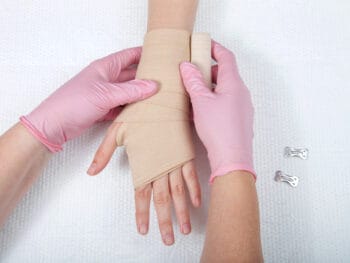Work injuries happen with little warning. It’s not like you come in to work and receive an email that one of your employees is going to saw his finger off around 9:32am. Those employers that are unprepared are usually those that miss out on collecting certain details of the injury. More common is the delay of treatment and/or reporting of the injury to their insurer/TPA since they are not ready or they are unsure what to do in general.
Proactive employers will sometimes perform a mock-injury, by pulling a certain employee aside and having them feign an injury. This way you can spot your weaknesses in your safety program and correct them so all parties are ready when the real injury happens. Below we discuss a few items a risk manager or safety person should keep well within their reach so they are ready when an injury happens.
Click Link to Access Free PDF Download
“13 Research Studies to Prove Value of Return-to-Work Program & Gain Stakeholder Buy-In”
-
Make sure your internal injury reporting forms are ready to go
All employers need to have their own internal reporting forms (if you don’t have any, contact us for help), and they are not scribbling down injury details on a Post-It note. The best internal reporting paperwork has 3 fields: One for the employee to complete, one for the supervisor to complete, and one for the risk manager or safety person or person in charge of the safety program to complete. This way you are assembling the injury details together by having a statement written direct from the employee on what happened, one from the supervisor, and one statement from the person in charge of reporting injuries to the carrier/TPA. Another great field has the employee list witnesses, and the person in charge needs to get with those witnesses right away to gather details so they are not forgotten. All of these details are greatly helpful to the adjuster on the claim. Remember it is hard to turn back the clock and talk with witnesses a week after an incident.
-
Have your carrier/TPA contact info and know where to send the injury report
Adjusters hate it when an agent or broker is the one turning in a work comp claim. This is because the Agent/Broker will sometime be missing information, or they will place the form on their desk and maybe forget to report the injury to the carrier until a few days or weeks later. The first few days to a week after the injury are the most crucial to the adjuster for gathering information, and any delay in that can further delay their investigation. Employers need to take charge on their injuries and be responsible for reporting directly to the carrier/TPA on the day the accident happened. I cannot think of one carrier/TPA that does not have 24-hour reporting capability, even if you have to fax the injury form in, or email it to your contact if you cannot call the claim in over the phone. Whatever method you prefer, you need to know who to contact and how to get a hold of them. Do not delay; get it reported at a minimum by the end of the workday.
-
Make sure everyone on the floor knows the next step
If the only people that know about your injury reporting program are the people on the safety committee, then you are missing a lot of crucial steps to having a smoothly operating system. Even to go as far as the floor supervisors is not far enough. Every employee needs to know what to do when an injury occurs. Again one of the best ways to enforce this program is to have a few mock injury runs every now and then. Practice makes perfect, even though these injuries are not real it is important for all people involved to know what to do, and to know what questions to ask, when to ask them, and how to record the information.
For example, if a machine were to malfunction and injure an employee, what do you do with the machine? Do you keep it running and carry on with your day? Of course not. A machine involved in an injury needs to be stopped right when the injury happens, and it needs to be tagged and removed from the work floor if possible. Nothing should be touched by anyone. Nobody should be able to touch the machine unless they are authorized by management to do so. This is important in case there is subrogation against the maker of the machine, or subrogation against an outside vendor that maintains and maintenances the machine. Once a person touches the machine and begins to operate it, you can lose out on the opportunity to pursue subrogation (depending on the machine, injury, and jurisdiction of course).
FREE DOWNLOAD: “13 Research Studies to Prove Value of Return-to-Work Program & Gain Stakeholder Buy-In”
-
Where do you send injured employees?
When an injury happens, where does the worker go for treatment? Where is the closest hospital if this injury needs immediate care? Is someone in charge of driving this worker to the clinic or hospital? If so, do they know where the clinic is and what authorization forms to bring with them so the clinic will treat the patient?
These are all important questions, and all questions that need answers. If someone is to provide transport for the injured worker, obviously they need to know where to go. Not every injury is an immediate emergency. If you take someone to the ER for a back strain, they will probably be sitting there for hours before getting treatment. In your jurisdiction, can workers be taken to their own doctors for care? If not, you need to provide a few occupational clinics or Urgent care clinics. If a worker can go to their own doctor, did you gather their doctor information and contact numbers? Does the employee know that they are to get a copy of their work restriction forms and send them back to their employer right away? It is these scenarios where employers miss out on providing light duty work opportunities, which can cost additional lost wages to be paid. Everyone has to be on the same page, and it comes back to communication. Each person needs to know their role, and what their responsibilities are.
Summary
These are only a few things for you have an effective work comp injury program. As mentioned numerous times above, communication is key. Everyone has to know what they are supposed to do. Not just the members of the safety committee, not just the members of management, and not just the supervisors. Everyone needs to know their role in a safety program, and that means every employee, every day. You never know when an injury is going to happen. It doesn’t matter if it is a minor injury or a major one. An injury is an injury, and the minor ones are the ones that can come back to bite you.
Author Michael B. Stack, CPA, Director of Operations, Amaxx Risk Solutions, Inc. is an expert in employer communication systems and part of the Amaxx team helping companies reduce their workers compensation costs by 20% to 50%. He is a writer, speaker, and website publisher. www.reduceyourworkerscomp.com. Contact: mstack@reduceyourworkerscomp.com.
©2013 Amaxx Risk Solutions, Inc. All rights reserved under International Copyright Law.














